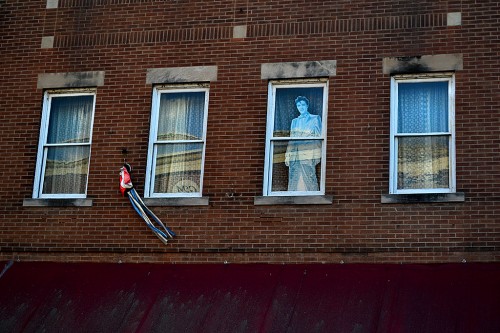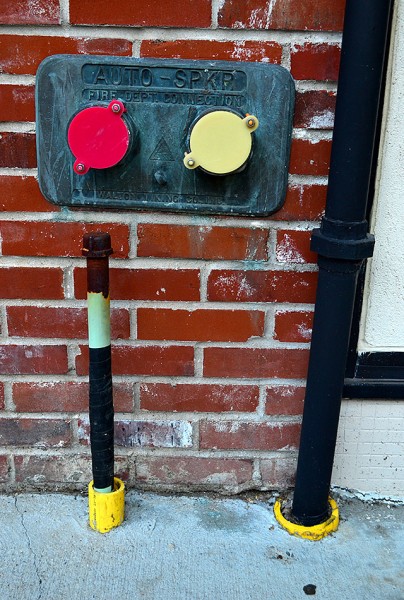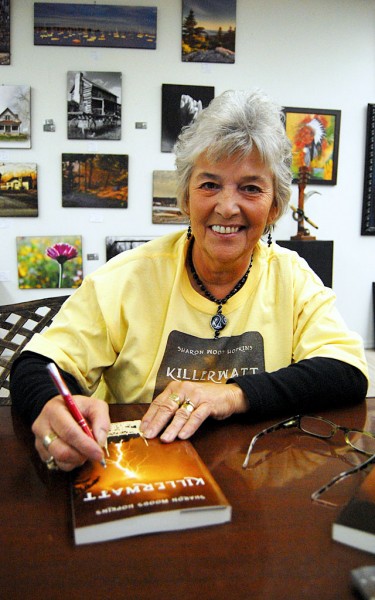 Sharon Woods Hopkins, author of Killerwatt, is a Panther.
Sharon Woods Hopkins, author of Killerwatt, is a Panther.
She divides the world of writers into two camps: the Plodders, who work on a set schedule and approach writing as a slow, methodical slog; and the Panthers, who pounce on writing whenever they have something to say and the time to record it.
[I’d add a third P – the procrastinators, which is me.] Click on any photo to make it larger, by the way.
UPDATE:
After I wrote this post, Sharon gently pointed out that it was time to get my hearing checked. She said she was a “pantser,” not a panther. It’s probably good I didn’t label her a “cougar.”
A pantser, Writer’s Digest clarified, “is a term most commonly applied to fiction writers, especially novelists, who write their stories “by the seat of their pants.” The opposite would be a plotter, or someone who uses outlines to help plot out their novels.
“I’m all Panther”
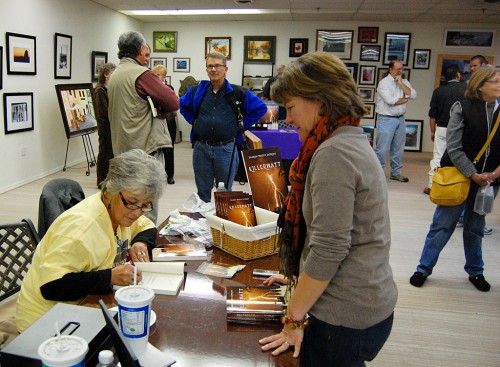 “I’m all Panther,” she said at her Painted Wren Gallery book signing on Nov. 4, 2010. “I sit down when I have time and when I know I can devote my time without interruption. I might write for five or six hours. I don’t plan it. I’m not by the clock.”
“I’m all Panther,” she said at her Painted Wren Gallery book signing on Nov. 4, 2010. “I sit down when I have time and when I know I can devote my time without interruption. I might write for five or six hours. I don’t plan it. I’m not by the clock.”
Cape area thriller
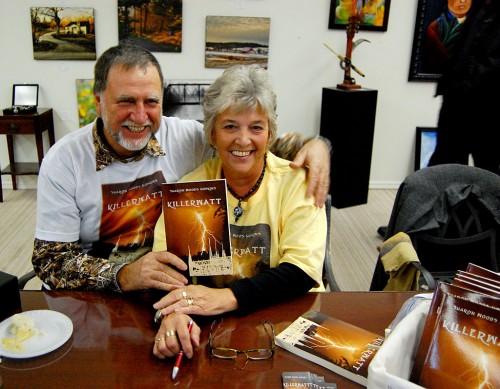 Sharon has written a mystery thriller with lots of Cape Girardeau area landmarks mentioned: Cape, downtown, Perryville, Scott City, Marble Hill and lots of familiar streets. (She did change a local hospital to St. Mark’s. “I didn’t want a lawsuit.”)
Sharon has written a mystery thriller with lots of Cape Girardeau area landmarks mentioned: Cape, downtown, Perryville, Scott City, Marble Hill and lots of familiar streets. (She did change a local hospital to St. Mark’s. “I didn’t want a lawsuit.”)
In fact, I told her after I had read the book that I had a minor quibble. I thought she might have been too explicit in her locations and directions. “Folks who don’t live here won’t care about the detail; folks like me get bogged down in following the chase by landmarks and say, ‘Wait a minute: Those streets don’t intersect.”
“You want an argument or a story?”
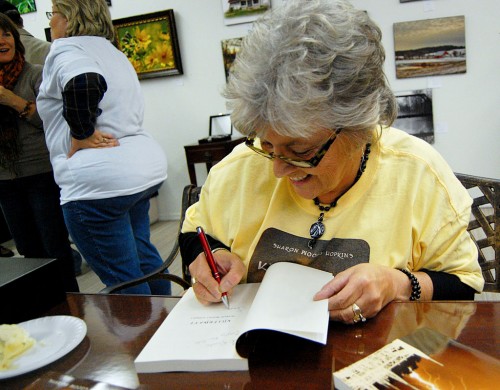 Sharon admitted that “some of the geography was tweaked to make the story work.” She mentions that in the acknowledgements: “As my dad would have said to anyone taking issue with that, ‘What do you want, an argument, or a story?'”
Sharon admitted that “some of the geography was tweaked to make the story work.” She mentions that in the acknowledgements: “As my dad would have said to anyone taking issue with that, ‘What do you want, an argument, or a story?'”
“It’s a ‘goal’ kind of novel” she explained. “The protagonist has a goal to get to (saving the country) and things happen to knock her back.”
That’s an understatement. People turning up dead, shot, nearly drowned and / or poisoned in the hospital go beyond the “knock her back” category in my book, but, of course, Sharon is a Canadian who ended up in Marble Hill married to my student body president campaign manager Bill Hopkins. She probably uses a different dictionary than most of us.
Rhetta isn’t Sharon per Sharon
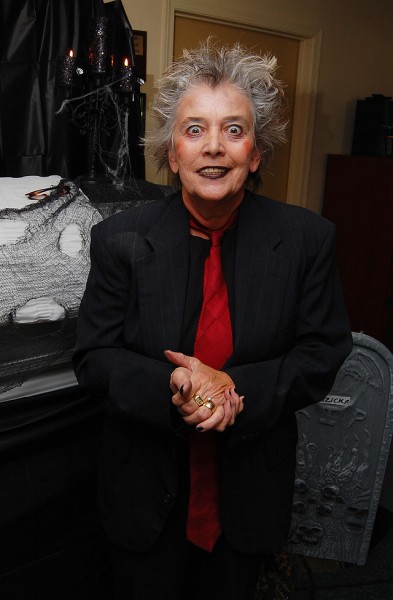 Sharon denies that she modeled Rhetta McCarter after herself. I mean, they’re only both insurance/mortgage agents; only both drive hot old Cameros; only both have .38s, and only both got a mistaken voicemail message from a possible terrorist. Oh, yes, both of them got blown off by the authorities when they tried to report it.
Sharon denies that she modeled Rhetta McCarter after herself. I mean, they’re only both insurance/mortgage agents; only both drive hot old Cameros; only both have .38s, and only both got a mistaken voicemail message from a possible terrorist. Oh, yes, both of them got blown off by the authorities when they tried to report it.
“I’m not nearly as foolhardy as she [Rhetta] is. I wouldn’t have done the things she did to save the country.”
[I’m not sure if this is Rhetta or Sharon. I shot it at Sharon’s office party last year.]
“I draw upon real people”
 If you are in Sharon’s orbit, you might find yourself in the book. “I draw upon real people. I took different pieces from real people I knew. I knew how the book was going to end and I had a beginning. In the middle, I would think that this might happen or that might happen and suddenly a character would appear. I’d think, ‘Oh, where did HE come from?’ He might become a central or a secondary character. When I’m in the middle of a book like this one or the one I’m writing now, these characters are real to me. I even talk to them. They’re real people.”
If you are in Sharon’s orbit, you might find yourself in the book. “I draw upon real people. I took different pieces from real people I knew. I knew how the book was going to end and I had a beginning. In the middle, I would think that this might happen or that might happen and suddenly a character would appear. I’d think, ‘Oh, where did HE come from?’ He might become a central or a secondary character. When I’m in the middle of a book like this one or the one I’m writing now, these characters are real to me. I even talk to them. They’re real people.”
[Here are some real people from her office. I shot them at Halloween 2010. I don’t know if they are in the book. I don’t recognize their characters.]
Did I like the book?
 So, did I like the book? I knocked it off in a couple of hours. When I was on the road, I’d pick a book that was interesting enough that I would keep reading it, but that wasn’t so interesting that I’d stay up all night to finish it. This would fall into the stay-up-all-night category.
So, did I like the book? I knocked it off in a couple of hours. When I was on the road, I’d pick a book that was interesting enough that I would keep reading it, but that wasn’t so interesting that I’d stay up all night to finish it. This would fall into the stay-up-all-night category.
In the interest of full disclosure, Sharon was kind enough to give me a copy of the book and to thank me (and others) for letting her pick our brains.
Bill said Sharon needed journalese translations
 I got an email from Bill saying, “My wife is writing a novel where a bad guy gets killed in a car wreck. I told her that her journalisticese needed to be honed by a professional (and that would be you).” She wanted a short news report about the first victim going into the Diversion Channel.
I got an email from Bill saying, “My wife is writing a novel where a bad guy gets killed in a car wreck. I told her that her journalisticese needed to be honed by a professional (and that would be you).” She wanted a short news report about the first victim going into the Diversion Channel.
I complied with a Joe Friday, just-the-facts version that was more or less incorporated in Chapter One.
Then, not knowing when to leave well enough alone, I sent her this version. I’m not a fiction writer on purpose (if you discount some of the expense reports I submitted), so this was a stretch for me.
She made nice noises and refrained from saying that my narrative was longer than her novel. Since it’s never going to get published anywhere else, here it is. You have my permission to skip it. Nothing of value is going to happen after this paragraph.
Finding the vic in the Diversion Channel
Sheriff’s diver Frank James pulled himself out of the water by the tow cable attached to the Blue 2006 Toyota Celica. He opened the door and water, along with a two-pound catfish poured out.
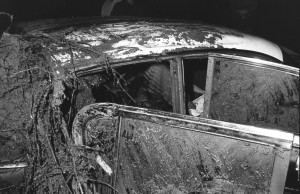 “OK, haul away. It’ll be a lot lighter now,” he hollered at the tow truck driver.
“OK, haul away. It’ll be a lot lighter now,” he hollered at the tow truck driver.
He dropped his SCUBA tank on the ground, pulled off his gloves and mask and collapsed on the running board of Pumper 103 called in from Cape Girardeau for mutual aid.
“Not right now,” he said, shaking his head and giving a wave-off gesture. “I have to get my heart rate under control and get my thoughts straight.”
I had to rewind the movie
A few minutes later, he gave a head nod that indicated that it was OK to come over. “Man, I’ve never had that happen before,” he said. “I had to sort of rewind the movie in my head to make sense of it all.”
“Here’s the way it’s going to work,” he continued. “I only want to have to tell this story once. Shoot, I only want to have to THINK about this story once. The deal is that’s it’s off the record. I don’t want to see a tape recorder. I don’t want to see a notebook. If I ever hear that you’ve told anyone what I’m about to tell you, then you’ll never get anything from me again.
“When I’m done with this, I’ll give you a formal statement. I know you don’t like doing that and you’re on deadline, but that’s the way it’s gonna be.”
I’ve done tens of dives
Seeing a shrug that he accepted as agreement, he kept going. “I’ve done tens of these dives; scores if you count training. Normally they go the same way. Either the car is empty and you have to search around because the person was ejected or escaped and left the scene, or the person is still strapped in their seatbelt. That’s one of the good things about seatbelt laws. It makes it easier to find the vics.
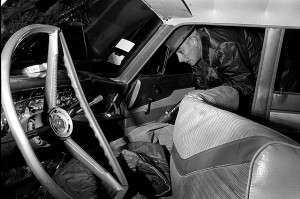 “Anyway, I hooked up the tow cable so the car wouldn’t get away, then I deployed two floating air bags to keep the car from sinking any more. There was no rush. This was recovery, not rescue. The water pressure was equalized between the inside and outside, so opening the door was no sweat.
“Anyway, I hooked up the tow cable so the car wouldn’t get away, then I deployed two floating air bags to keep the car from sinking any more. There was no rush. This was recovery, not rescue. The water pressure was equalized between the inside and outside, so opening the door was no sweat.
“This wasn’t one of the lucky ones where the poor stiff was belted in. I swept under the dash area, but no joy. When I was outside the car, the only way you could tell which way was up was by a dim glow above you. Inside the car you didn’t even have the glow. The water was so murky that my light wouldn’t penetrate more than about six inches.
“Someone was watching me”
“After searching the front part of the car, I stretched out to swim over the seats to get into the rear. I had the strangest sensation that someone was in there with me, watching me. Your mind plays tricks like that when you’re in the dark. It’s easy to get turned around.
“Suddenly, this hand came down from nowhere and started to grab my regulator. Jesus, it was like something out of a Grade B horror movie. I started thrashing around trying to get out of there and suddenly it had wrapped its arms around me. I was on the verge of panic. I was sucking air out of the tank like crazy. I had to get out before that thing either grabbed my mask or I ran out of air.
“Just then I realized that this thing wasn’t going to hurt me. It was just the vic who had floated to the ceiling of the car. I had pushed off between him and the car seats. My air bubbles must have displaced enough water to move him and cause his hand to drop down into my field of vision.
“Holy crap in a canvas bag!”
“Holy crap in a canvas bag! I had to stay in that car long enough that I didn’t look like some kind of wild-eyed freak show when I surfaced. The guys would never have let me live that down.
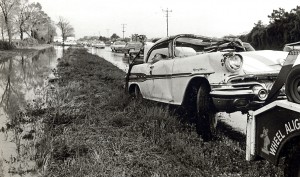 “After I settled down, I did a quick feel of the victim. I couldn’t detect any obvious signs of trauma that would account for his death. I can only speculate that the car went under quickly and he couldn’t figure out how to get out. He managed to get his nose into a tiny air pocket that must have kept him alive for quite a while. God, that must be a rough way to go. That poor bastard.
“After I settled down, I did a quick feel of the victim. I couldn’t detect any obvious signs of trauma that would account for his death. I can only speculate that the car went under quickly and he couldn’t figure out how to get out. He managed to get his nose into a tiny air pocket that must have kept him alive for quite a while. God, that must be a rough way to go. That poor bastard.
“OK,” he said.” I needed to tell that to someone. I didn’t want the guys I work with it to hear it because they’d always wonder if I’d freak out some day and get someone hurt. I don’t talk about stuff like that with my wife. Get your notepad out we’ll do this version for the world.”
He put on his official face and dictated, “Deputy Frank James arrived on the scene of a one-car auto accident on the west side of the Diversion Channel bridge on I-55 north of the Scott City Exit…”
I should have been a reporter
After I threw this together, I realized why I never saw reporters with muddy shoes. They make all this stuff up. It’s us poor photographers who have to actually be there.
Shameless Plug: Buy MY Book

Carla Jordan, director of the Lutheran Heritage Center and Museum has agreed to sell my Tower Rock: A Demon that Devours Travelers photo book by mail if anyone doesn’t want to make the trek to Altenburg. Here’s the contact info. The price is $14 plus postage.
Lutheran Heritage Center & Museum
P.O. Box 53
75 Church Street
Altenburg, Missouri 63732
Telephone
573-824-6070
Email:
info@altenburgmuseum.org



